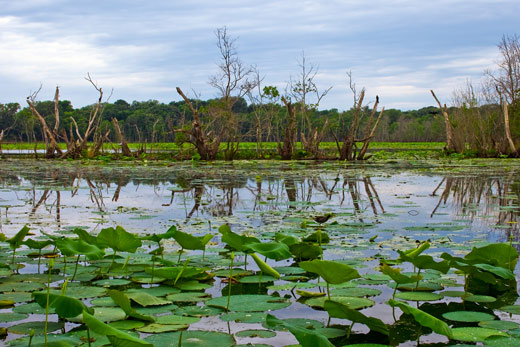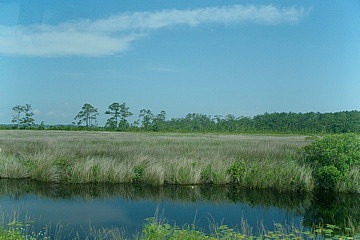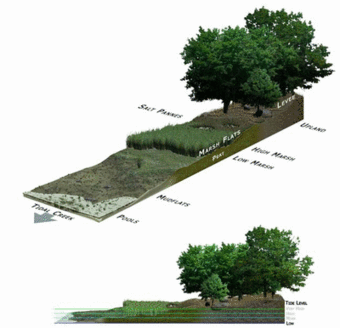 |
 

 |
|
| The Home Stores |
A marsh is a type of wetland, featuring grasses, rushes, reeds, typhas, sedges, cat tails, and other herbaceous plants (possibly with low-growing woody plants) in a context of shallow water. A marsh is different from a swamp, which is dominated by trees rather than grasses and low herbs. The water of a marsh can be fresh, brackish or saline. Coastal marshes may be associated with estuaries and along waterways between coastal barrier islands and the inner coast. Estuarine marshes often are based on soils consisting of sandy bottoms or bay muds. |
Marsh and Marshes |

The shallow-water marsh provides feeding grounds for "wading" birds such as cranes and egrets. The marshland is "ephemeral", meaning that the water supply is dependant upon seasonal periods of precipitation and run-off. There are times during the year that the shallow water marsh area may be completely dry.

Wetlands are areas where soils are saturated or covered with water. Though we call them swamps, sloughs, marshes or potholes, these are areas where land and water meet. Freshwater marshes are low-lying, open areas located near creeks, streams, rivers and lakes, where water flows into the marsh. The water level ranges from one to six feet deep, depending on the season. A freshwater marsh teems with life; plants and animals co-exist in a complex many layered ecosystem.
Freshwater marshes are often found in open areas near rivers and lakes. They are very common at the mouths of rivers and form in areas with mineral soil that drains very slowly. The water in freshwater marshes is usually one to six feet deep and is rich in minerals. Water flows into marshes from rain or from a water source like creeks, streams, or rivers.
Low-growing plants like grasses and sedges are common in freshwater marshes. Bulrushes and cattails are often found at the edges of a marsh. There are very few trees in freshwater marshes. Animals like mink, raccoons, opossums, muskrats, beavers, frogs, turtles and lots of species of birds and insects are common in marsh lands. Freshwater marshes can vary in size from very small to very large! The largest freshwater marsh in the United States is the Florida Everglades.
Once considered useless - a miserable bug-infested wasteland - wetlands are the most productive ecosystems in the world. Furthermore, marshes are invaluable at controlling and purifying water. Marsh plants store the nitrogen and phosphorus generated by agricultural run-off and then utilize them for growth. Marshes also improve water quality because they act as settling basins for upland runoff. The thick vegetation slows the flow of water entering the marsh and suspended soil particles settle out. Wetlands are giant sponges make up of organic matter that can absorb up to 18 times their weight in water. During heavy rains, the marsh holds water and then releases it slowly back into the watershed. Because they are filled with plants, marshes stabilize soils and reduce stream velocity.
Freshwater marshes teem with life; both animals and plants flourish here. Cattails are the most recognizable marsh plant, but saw grass, pickerelweed, spike rush and bulrush all poke up through the wet soil. Water lilies float on the surface along with algae and duckweed. Animals live in all the levels of the marsh, in the water, on the surface of the water, above the surface and on the land surrounding the marsh.

A salt marsh forms when incoming tides carry and deposit sediment across low-lying land, resulting in wet mudflats. Saltwater grasses then slowly take hold and spread, stabilizing the land through the growth of root systems. As the plants decay and sediment builds up, peat deposits accumulate, forming a rich habitat that supports the growth of hundreds of diverse organisms.
A salt marsh is thus a place where the land meets the sea, created through tidal action over a span of hundreds of years. This unique habitat is confined to a narrow coastal fringe along shallow, protected bays. A healthy marsh maintains a delicate balance between salt water and fresh water, especially further inland where a salt marsh may merge with a brackish area or a freshwater swamp. Closer to the shoreline, the ebb and flood of daily tides creates zones:
As you walk along the edge of the marsh, observe whether the tide is low or high, and try to identify the various zones created through the action of the tides.
